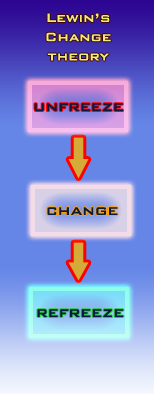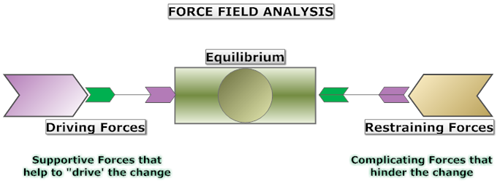Learning Activity 1:
The Change Process and Lewin's Theory
"You must be the change you wish to see in the world." - Mahatma Ghandi
"If you want to truly understand something, try to change it." - Kurt Lewin
Overview
 The theoretical foundations of change theory are robust, several theories now exist, many coming from the disciplines of sociology, psychology, education, and organizational management. Kurt Lewin (1890-1947) has been acknowledged as the father of social change theories and presents a simple yet powerful model to begin the study of change theory and processes. He is also lauded as the originator of social psychology, action research, as well as organizational development.
The theoretical foundations of change theory are robust, several theories now exist, many coming from the disciplines of sociology, psychology, education, and organizational management. Kurt Lewin (1890-1947) has been acknowledged as the father of social change theories and presents a simple yet powerful model to begin the study of change theory and processes. He is also lauded as the originator of social psychology, action research, as well as organizational development.
Lewin's change theory consists of three distinct and vital stages:
- Unfreezing
- Moving to a New Level or Changing
- Refreezing.
Lewin recognized the role of habit in people's thoughts and actions.
"Unfreezing" involves finding a method of making it possible for people to let go of an old pattern that was counterproductive in some way.
"Moving to a new level" involves a process of change--in thoughts, feelings, behavior, or all three, that is in some way more liberating or more productive.
"Refreezing" is establishing the change as a new habit, so that it now becomes the "standard operating procedure." Without some process of refreezing, it is easy to backslide into the old ways.
Force Field Analysis
Lewin also created a model called force field analysis which offers direction for diagnosising situations and managing change within organizations and communities. Lewin assumes that in any situation there are both driving and restraining forces that influence any change that may occur. According to Lewin's theories, human behavior is caused by forces, beliefs, expectations, cultural norms, and the like within the life space of an individual or society. These forces can be positive, urging us toward a behavior, or negative, propelling us away from a behavior.
Driving Forces
Driving forces are those forces affecting a situation that are pushing in a particular direction; they tend to initiate a change and keep it going. In terms of improving productivity in a work group, pressure from a supervisor, incentive earnings, and competition may be examples of driving forces.
Restraining Forces
Restraining forces are forces acting to restrain or decrease the driving forces. Apathy, hostility, and poor maintenance of equipment may be examples of restraining forces against increased production.
Equilibrium
This equilibrium, or present level of productivity, can be raised or lowered by changes in the relationship between the driving and the restraining forces. Equilibrium is reached when the sum of the driving forces equals the sum of the restraining forces.
Change Model Categories
In general, three categories of change models exist: empirical-rationale, power-coercive, and normative-educative models (see table 1 below).
| Change Model Paradigm | Characteristics |
|---|---|
| Power Coercive | Leader orders change, subordinates comply Change agent must have authority Origin of regulations and laws May be used to force a change, ie: desegregation laws May fail due to high resistance |
| Empirical Rationale | Emphasis on Reason and Knowledge Based on premise that people will change once they realize it serves their rationale self interest Recipients are not actively involved in change process but are educated about the values Often used for technological change Ignores beliefs, feelings, values |
| Normative Educative | Change only really occurs once attitude, values, skills, relationship changes are made Those affected by the change MUST be involved in the planning Mutual trust and collaboration needed Conflict must be resolved amicably Kurt Lewn's theory is an example |
Hohn (1998) identified four different types of change: Change by exception, Incremental Change, Pendulum Change and Paradigm Change.
Change by Exception: occurs when someone makes an exception to an existing belief system. For instance, if a client believes that all nurses are bossy, but then experiences nursing care from a very modulated nurse, they may change their belief about that particular nurse, but not all nurses in general.
Incremental Change: change that happens so gradually, that an individual is not aware of it.
Pendulum Changes: are changes that result in extreme exchanges of points of view.
Paradigm Change: involves a fundamental rethinking of premises and assumptions, and involves a changing of beliefs, values and assumptions about how the world works.
A Change Agent is someone who deliberately tries to bring about a change or innovation, often associated with facilitating change in an organization or institution. To some degree, change always involves the exercise of power, politics, and interpersonal influence. It is critical to understand the existing power structure when change is being contemplated. A change agent must understand the social, organizational, and political identities and interests of those involved; must focus on what really matters; assess the agenda of all involved parties; and plan for action.
Change occurs over time, often fluctuating between intervals of change then a time of settling and stability.
Ends In View
This learning activity is intended to provide learners with the opportunity to:1. Apply Lewin's Change and Force Field Analysis theories to selected situations.
2. Identify driving and restraining forces that influence change.
3.Apply basic change theories to nursing issues and situations.
4.Distinguish reactive change from planned change.
5.Recognize the role of nurses as change agents.
6.Distinguishes between empirical-rationale, power-coercive, and normative-educative change models.
7.Analyzes Hohn's four different types of change.
In Practice
1. Participate in class discussion about the process of change and how Lewin's change theory has served as a template for many subsequent change theories.
2. Chung and Nguyen give a clear account of how they applied Lewin's change theory to improve pain outcomes in a Texan hospital. In small groups, choose a nursing situation or practice aspect where Lewin's theory could be applied to spur necessary change. Draw a model of your work and share with the rest of the class.
3. Using the diagram in Figure 1 participate in class discussion to brainstorm forces that are in play due to the problem of the nursing burnout.
4. In small groups, refer to the information in Table 1 at the end of this learning activity in your course manual and above. Discuss three examples of an appropriate use of each of the three change paradigms (one example for each) and share with the class.
In Reflection
1. Reflect on the class discussions, and notice if your view of the change process has expanded. Jot down your thoughts.
2. What traits (if any) will you need to cultivate to feel comfortable operating as a change agent?
3. Examine your own feelings and thoughts about taking this course. What strategies can you use to feel comfortable with the process of change?
 IN PREPARATION:
IN PREPARATION: